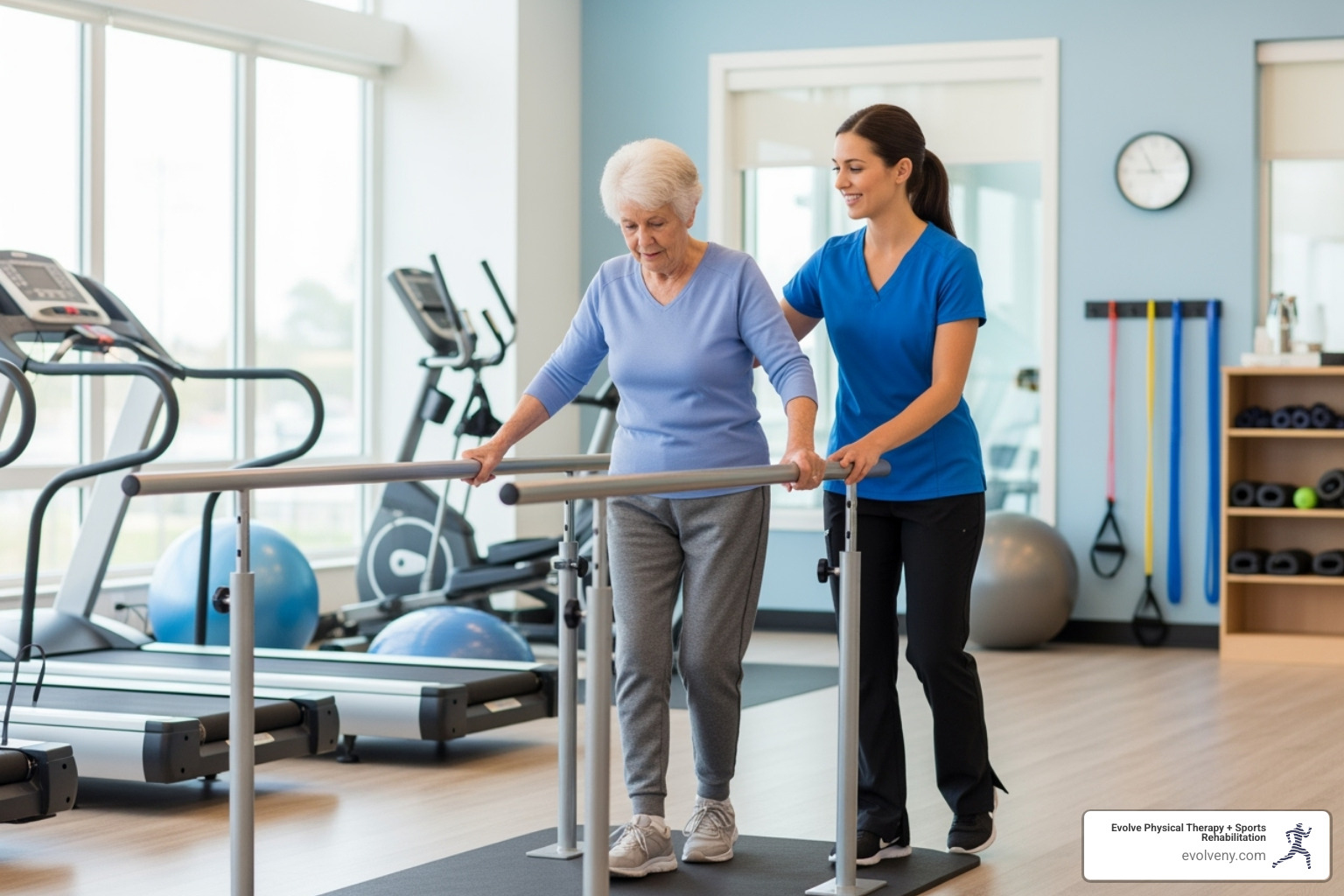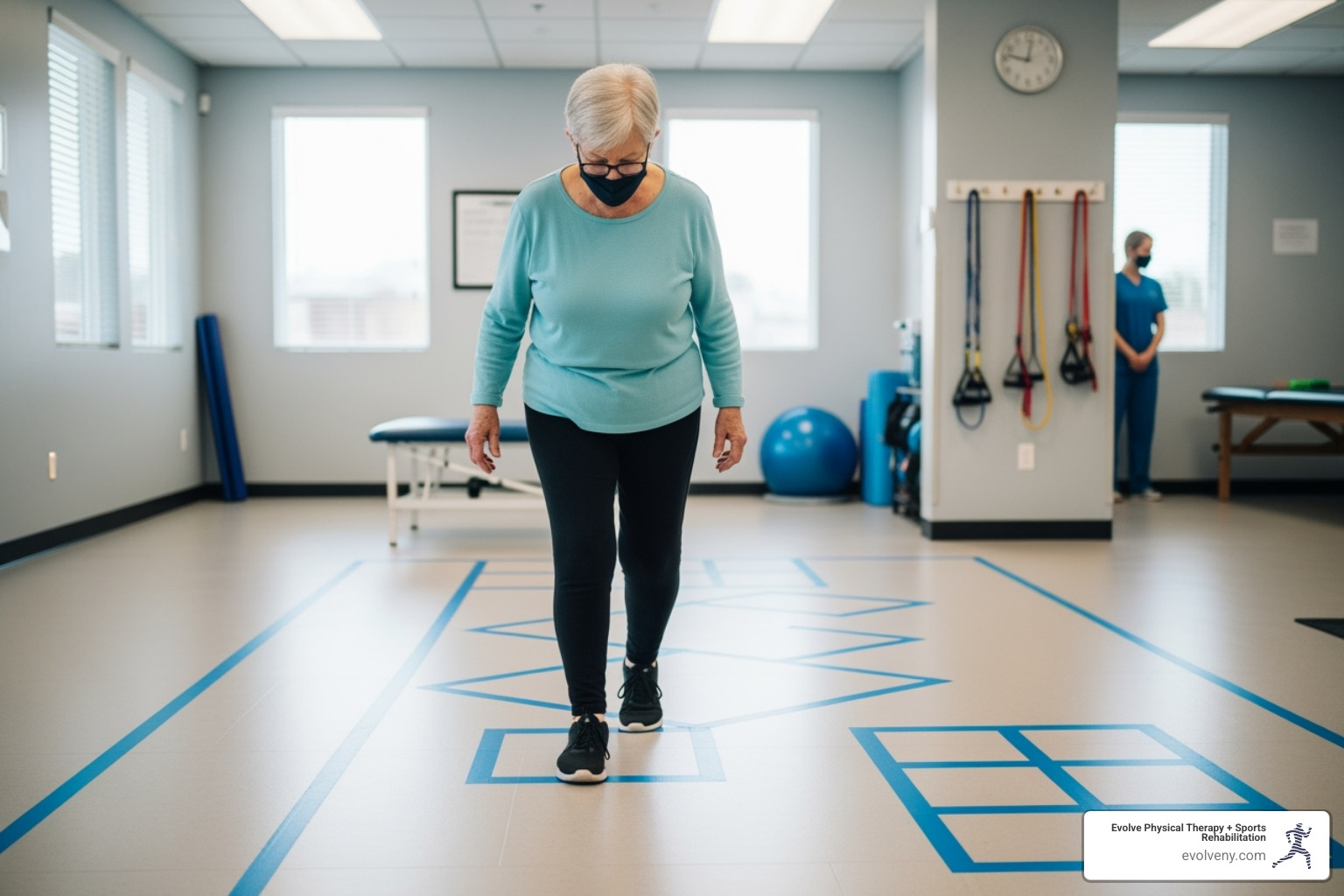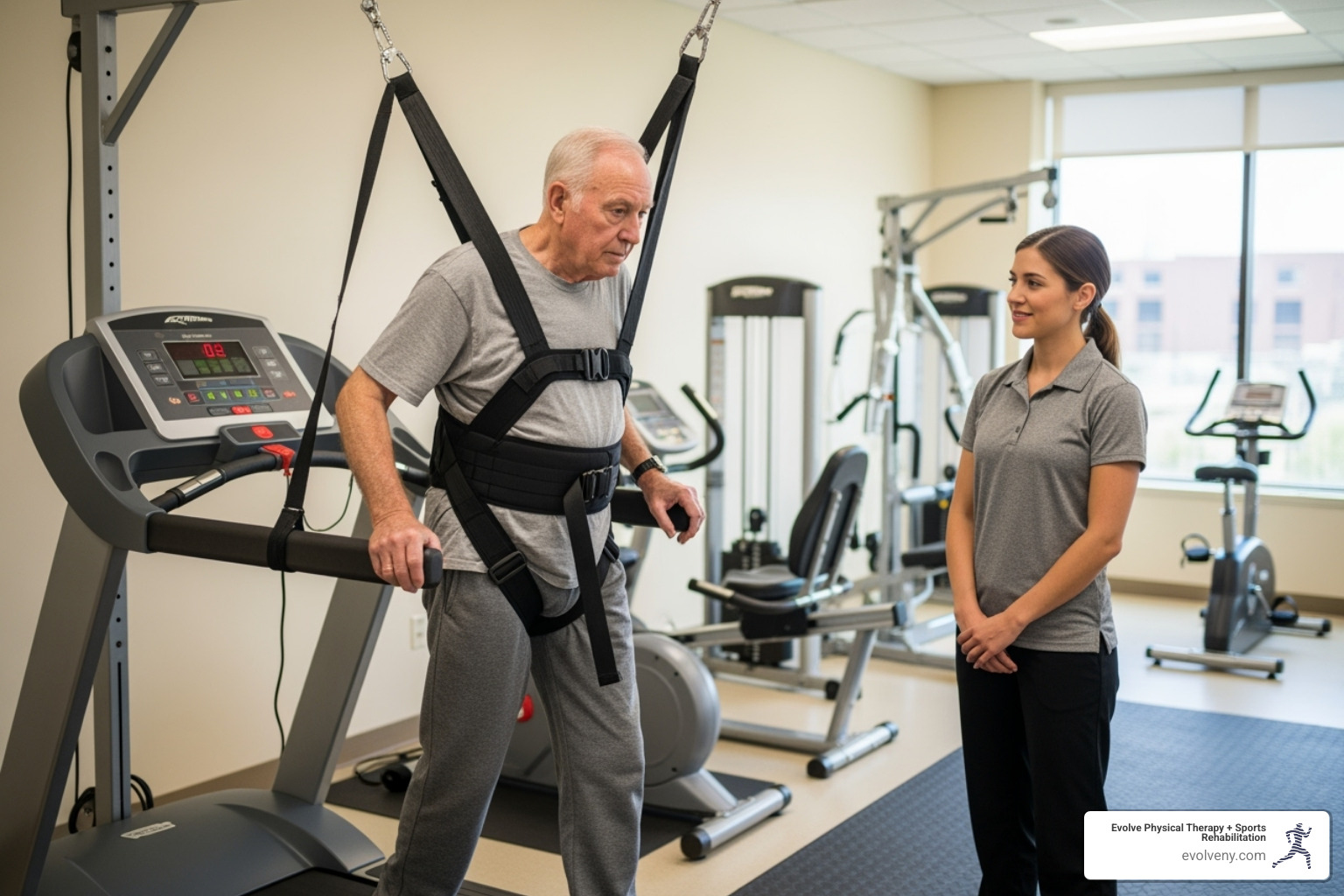Parkinson's Gait Training: Putting Your Best Foot Forward
Understanding the Challenges of Parkinsonian Gait

Gait training for parkinsons is a specialized form of physical therapy that helps people with Parkinson's disease improve their walking patterns, reduce fall risk, and maintain independence. Research shows this targeted approach can significantly improve walking speed, stride length, and overall mobility.
Key Gait Training Methods for Parkinson's:
- External cueing - Using visual lines, auditory beats, or tactile cues to improve step timing
- Treadmill training - Body-weight supported walking to practice normal gait patterns
- Dual-task training - Combining cognitive tasks with walking to improve real-world function
- Dance and movement therapy - Rhythmic activities that improve balance and coordination
- Strength and flexibility exercises - Building the physical foundation for better walking
Studies show a sobering 59% of people with Parkinson's experience falls within a six-month period, highlighting why gait training is essential. These challenges, including shuffling steps and stooped posture, stem from dopamine deficiency in the brain, which disrupts movement control.
The good news is that gait training works. Research shows participants can increase walking speed from 1.28 to 1.45 m/s—a change that significantly impacts real-world safety and independence. A change like that can mean the difference between crossing a street safely or not.
At Evolve Physical Therapy, we specialize in individualized gait training for parkinsons. Our hands-on approach helps patients regain mobility and confidence, proving that with the right techniques and consistent practice, people with Parkinson's can maintain their independence and quality of life.
The "Why" Behind Gait Issues: Causes and Medical Interventions
Walking challenges in Parkinson's disease aren't about weak muscles alone. They stem from a complex neurological issue where the brain's movement control center isn't getting the right signals. When we talk about gait training for parkinsons, we must first understand this root cause.
Defining Characteristics of Parkinsonian Gait
Parkinsonian gait has several distinct patterns:
- Stooped posture: A forward-leaning posture is a primary characteristic, throwing off balance.
- Shuffling and reduced stride length: This is often paired with shuffling, where feet drag instead of lifting, and a shorter stride length, which slows walking speed.
- Decreased arm swing: The natural arm swing that aids balance also diminishes or becomes uneven.
- Festination: Steps can become uncontrollably shorter and faster, as if the person is chasing their own center of gravity.
- Freezing of gait (FOG): This is a temporary, sudden inability to move, as if the feet are glued to the floor. It often occurs in doorways or during turns and is a major cause of falls.
- Difficulty turning: Turning is also difficult, often requiring multiple small, rigid steps instead of a smooth pivot.
These changes represent a loss of the automatic walking pattern most of us take for granted. For deeper insights, researchers have documented detailed gait dynamics that help us understand what's happening.
Underlying Neurological Causes
These gait issues are rooted in a shortage of dopamine, a key brain chemical for movement, caused by the breakdown of dopamine-producing cells in the substantia nigra. This deficiency impairs the basal ganglia, the brain's movement control center.
Without enough dopamine, the basal ganglia can't send clear instructions to the muscles. This results in motor control impairment—not due to muscle weakness, but faulty signals from the brain. As this neurodegeneration progresses, symptoms worsen, which is why gait training for parkinsons focuses on teaching the brain new strategies to compensate for these damaged circuits.
Understanding these causes explains why simply being told to "walk more" isn't enough. Specialized approaches are needed to bypass these neurological challenges. The Michael J. Fox Foundation offers more information on how these symptoms develop.
How Medication and DBS Address Gait
Medical treatments are a key part of management, though they have limitations.
Levodopa, a dopamine replacement therapy, is the gold standard medication and can improve walking speed and step length. However, it often fails to fully address freezing or balance issues and can sometimes lead to unpredictable freezing as the disease progresses.
Dopamine agonists, which mimic dopamine, have a similarly inconsistent impact on complex gait problems. Some people see improvements, while others notice little change.
Deep Brain Stimulation (DBS), a surgical procedure involving implanted electrodes, can be very effective for tremor and stiffness. Its effect on gait is mixed; some patients see improvements in speed, while others see little change in freezing or balance. It is not a cure-all for walking challenges, as detailed by The Michael J. Fox Foundation.
This gap is precisely why comprehensive physical therapy is crucial, combining medical management with specialized rehabilitation to improve function and quality of life.
The Core of Gait Training for Parkinson's: Physical Therapy and Exercise

Gait training for parkinsons through physical therapy is about teaching your brain and body to work together in new ways, effectively rewiring the connections that Parkinson's has disrupted. People who participate see remarkable improvements: faster walking speeds, longer strides, and fewer falls.
Key Physical Therapy Strategies
- Movement strategy training is foundational. Instead of relying on the brain's damaged 'autopilot,' we break walking into conscious parts, using specific cues like "take a big step." This is adapted for all stages of Parkinson's.
- Balance exercises are crucial to reduce fall risk. We use varied surfaces and even fun tools like the Nintendo Wii Fit to challenge and improve stability in a controlled way.
- Strength training in the legs and core, through exercises like squats and lunges, provides the physical power needed for better walking and daily movements like standing from a chair.
- Flexibility work, including targeted stretching, counteracts the rigidity that restricts movement, especially in the trunk.
- Postural correction exercises help you stand taller, which immediately improves balance and movement.
Every person's program is different. Our goal is to give you back control over your movement. This evidence-based review provides excellent insights into what works.
The Role of External Cues in Gait Training for Parkinson's
External cues act like a guide for the brain, bypassing damaged circuits to improve walking.
- Auditory cues, like a metronome's beat or music, are highly effective. The rhythm provides an external signal that helps regulate pace and step length, leading to faster, longer steps.
- Visual cues, such as tape lines on the floor or a laser pointer, give the brain a concrete target to aim for. This is especially helpful for overcoming freezing.
- Somatosensory cues, like vibrating insoles, offer another tactile signal to guide movement.
Rhythmic cueing provides the steady beat the brain's internal rhythm generator can no longer supply.
The Power of Treadmill Training

Treadmill training for gait training for parkinsons offers a safe, controlled environment to practice walking without fear of falling. Body-weight supported treadmill training (BWSTT) is especially effective. A harness system supports some of your weight, allowing you to practice larger, more normal steps safely.
The results are measurable. One study showed treadmill trainees improved their walking speed from 1.28 to 1.45 m/s, while a control group saw almost no change. Trainees also took longer steps, reducing shuffling. The treadmill also allows for practice with starts and stops, preparing you for real-world scenarios.
Dual-Task Gait Training for Parkinson's: Engaging Mind and Body
In real life, we walk while doing other things. For people with Parkinson's, this 'dual-tasking' can be dangerous. That's where dual-task training becomes essential. We practice walking while performing cognitive tasks (like counting backward) or motor tasks (like carrying objects).
This trains the brain to divide attention, making you less likely to stumble when distracted. Research confirms that dual-task training improves step length and rhythm, building confidence for handling the complexities of daily life, as shown in case studies. The goal is to make everyday life easier by training your brain to multitask effectively while staying safe.
A Spectrum of Effective Exercises and Therapies
Effective gait training for parkinsons offers a variety of options to suit individual preferences and goals. Finding an activity you enjoy, from dance to boxing, is key to staying motivated and improving.
| Therapy Type | Primary Gait Benefits | Additional Quality of Life Benefits |
|---|---|---|
| Dance | Improves gait velocity and step length. Stimulates neuroplasticity, improves coordination, balance, and quality of life. | Improves balance, coordination, spatial awareness, musicality, and motor control. |
| Tai Chi | Improves balance and reduces fall risk. Improves posture alignment and stability. | Promotes mindfulness, reduces stress, and builds confidence in movement. |
| Boxing Programs | Increases agility, coordination, and motor function. Improves balance and reaction time. | Builds strength, boosts mood, and creates a strong sense of empowerment and community. |
Dance, Tai Chi, and Yoga
Dance therapy combines music and movement to produce remarkable gait improvements. Research on dance therapy benefits shows styles like Tango can improve gait velocity and step length, as the rhythm provides an external guide for the brain.

Tai Chi uses slow, flowing movements to improve balance, posture, and stability. This gentle practice builds confidence and has been shown to reduce fall risk. Yoga improves flexibility, strength, and body awareness. By lengthening tight muscles and promoting mindfulness, it can help make walking more fluid and manage anxiety that may trigger freezing.
Strength, Aerobic, and Boxing Programs
Vigorous exercise programs build the physical foundation for better walking and function.
- Resistance training builds muscle strength essential for improved walking and balance.
- Cycling is a great low-impact aerobic option for building leg strength and endurance, which can improve motor performance.
- Running, for some, with a proper heel-toe strike pattern may even help re-establish more normal gait mechanics.
Non-contact boxing programs, like Rock Steady Boxing, are particularly exciting. These high-intensity, full-body workouts are adapted for people with Parkinson's. Participants see improved balance, coordination, and motor function. Beyond the physical gains, these programs are incredibly empowering, building both strength and community.
Emerging Technologies: Robotics and Adaptive Footwear
New technologies are offering innovative ways to improve traditional therapy.
- Robotic-Assisted Gait Training (RAGT) uses devices like the Lokomat to guide a patient's legs through normal movement patterns. This high-intensity practice can improve gait speed, stride length, and reduce freezing.
- Wearable sensors, like Heel2Toe, provide real-time auditory feedback on gait quality, helping to correct walking patterns instantly.
- Future technologies like smart glasses may project visual cues directly into a user's field of vision to help initiate steps and prevent freezing.
- Adaptive footwear with features like special soles for stability can also make a significant difference, reducing shuffling and improving confidence.
Creating Your Plan: Management, Mindset, and Future Directions
A successful journey with Parkinson's requires a comprehensive plan. The best gait training for parkinsons programs are custom to the individual's physical needs, goals, and emotional well-being.
How to Choose the Right Program
Finding the right program involves building a support team and setting clear goals.
- Consult a neurologist to manage medications and monitor your progression, ensuring a coordinated care plan with your physical therapist.
- Work with a physical therapist specializing in neurological conditions. They will conduct a thorough evaluation to understand your specific challenges, from shuffling to freezing.
- Consider your disease stage. Early stages may focus on high-intensity exercise, while later stages emphasize safety and maintaining independence.
- Acknowledge personal preference. Whether you prefer group classes like Rock Steady Boxing or one-on-one sessions, the right fit boosts motivation and success.
- Set personal goals. Maybe you want to walk to the mailbox or play with grandchildren. We tailor your program to help you achieve what matters most to you.
The Impact of Anxiety on Freezing of Gait
Freezing of gait (FOG) is often triggered by specific situations, and anxiety can be a major factor. Feeling rushed, stressed, or worried about falling can make freezing episodes more frequent and severe. This stress response interferes with movement control, and the fear of falling can create a vicious cycle where worry about freezing makes it more likely to happen.
Stress management is a powerful tool. Simple deep breathing exercises or taking a moment to pause and reset can help break the anxiety-freeze cycle. Mindfulness is also a practical strategy. Focusing on your feet or humming a tune can help the brain bypass stuck pathways. As research shows, addressing anxiety is an essential part of effective FOG treatment.
Long-Term Outlook and Future Research
The future of gait training for parkinsons is bright, with our understanding of how to manage symptoms evolving rapidly. Maintaining gains requires making exercise a consistent part of your routine. Regular "booster sessions" with a physical therapist can help adapt your program as your needs change.
Exciting research suggests vigorous exercise may have neuroprotective effects, potentially slowing disease progression. Furthermore, advancements like wearable sensors and virtual reality are making rehabilitation more engaging and effective by providing real-time feedback on your walking patterns.
Future research aims to determine the optimal "dose" of exercise and integrate cognitive training. The goal remains to help you maintain independence, confidence, and quality of life for as long as possible.
Conclusion: Take the Next Step Towards Better Mobility
Understanding the challenges of Parkinson's is the first step. As we've explored, targeted physical therapy and gait training for parkinsons can transform daily life. The right intervention at the right time makes a clear difference.
Gait training works by addressing both the physical and confidence issues of movement difficulties. Measurable improvements in walking speed mean safer street crossings and greater independence. Modern gait training offers a variety of options, from dance and Tai Chi to Rock Steady Boxing. New technologies like robotics and smart sensors are making therapy more precise and engaging, ensuring there's an approach that fits you.
What matters most is taking that first step. Research clearly shows that regular, targeted gait training leads to meaningful improvements in mobility, balance, and quality of life. These aren't just statistics—they represent real people walking more confidently and falling less often.
At Evolve Physical Therapy + Sports Rehabilitation, we provide personalized, hands-on care. Our specialized approach to gait training for parkinsons, including our innovative Rock Steady Boxing program, empowers people to reclaim their mobility and take control of their future.
It's never too late to start. Prioritizing your mobility is a choice you can make today, leveraging your brain's remarkable ability to adapt and learn.
Ready to see what gait training for parkinsons can do for you? Learn more about our specialized Parkinson's programs and take the first step toward better mobility today. A more confident, mobile future is waiting.

